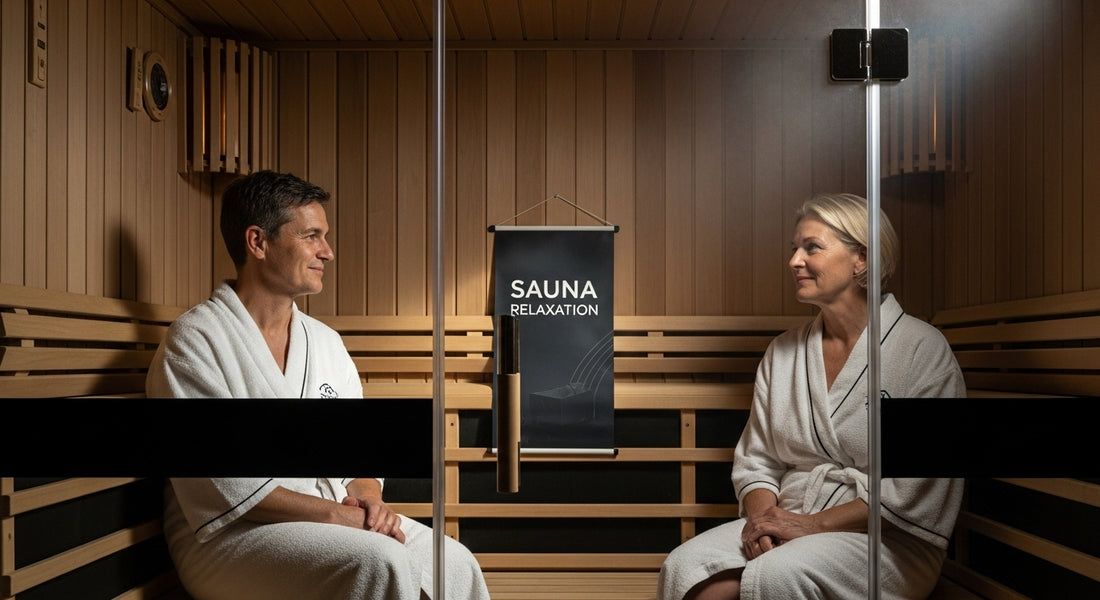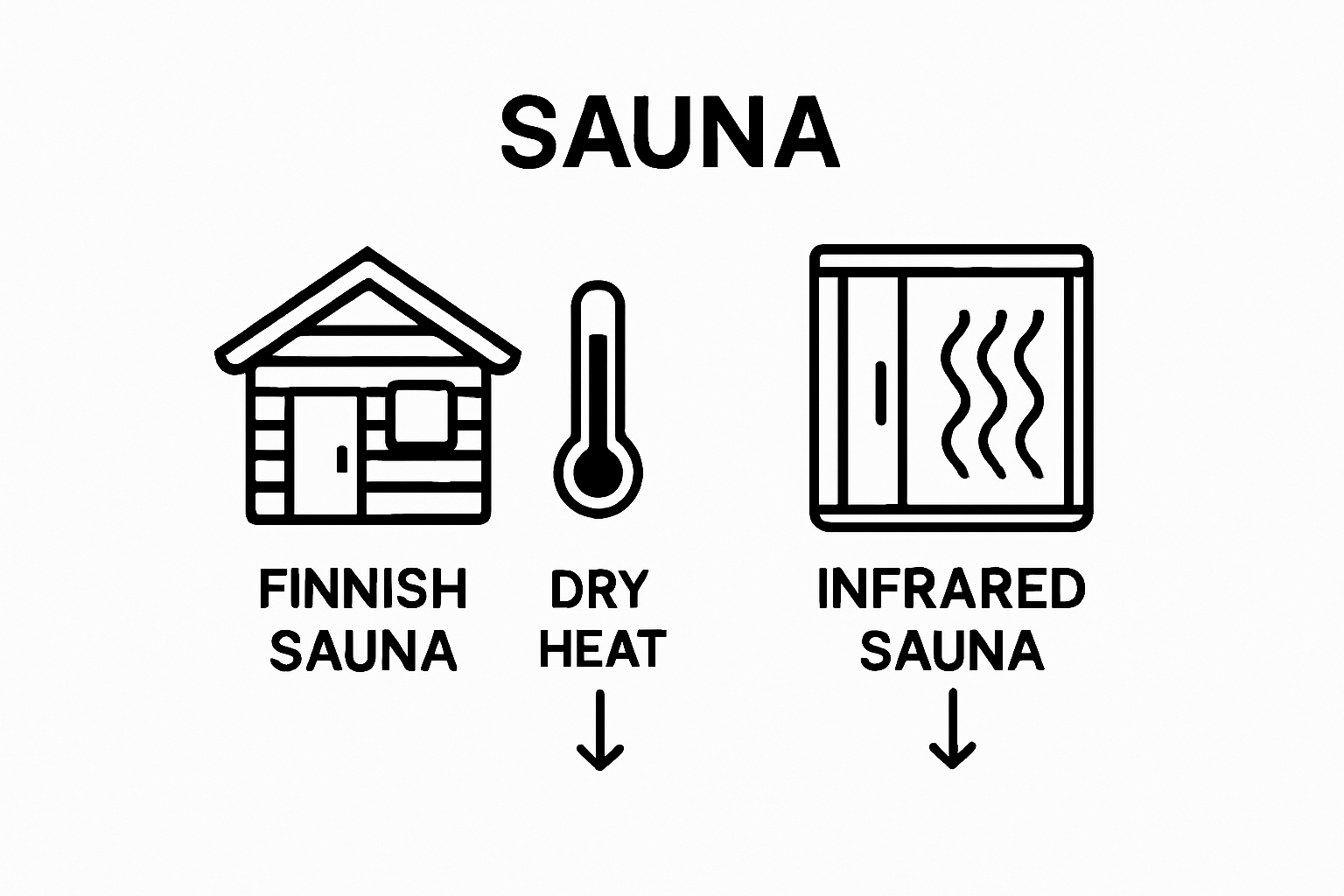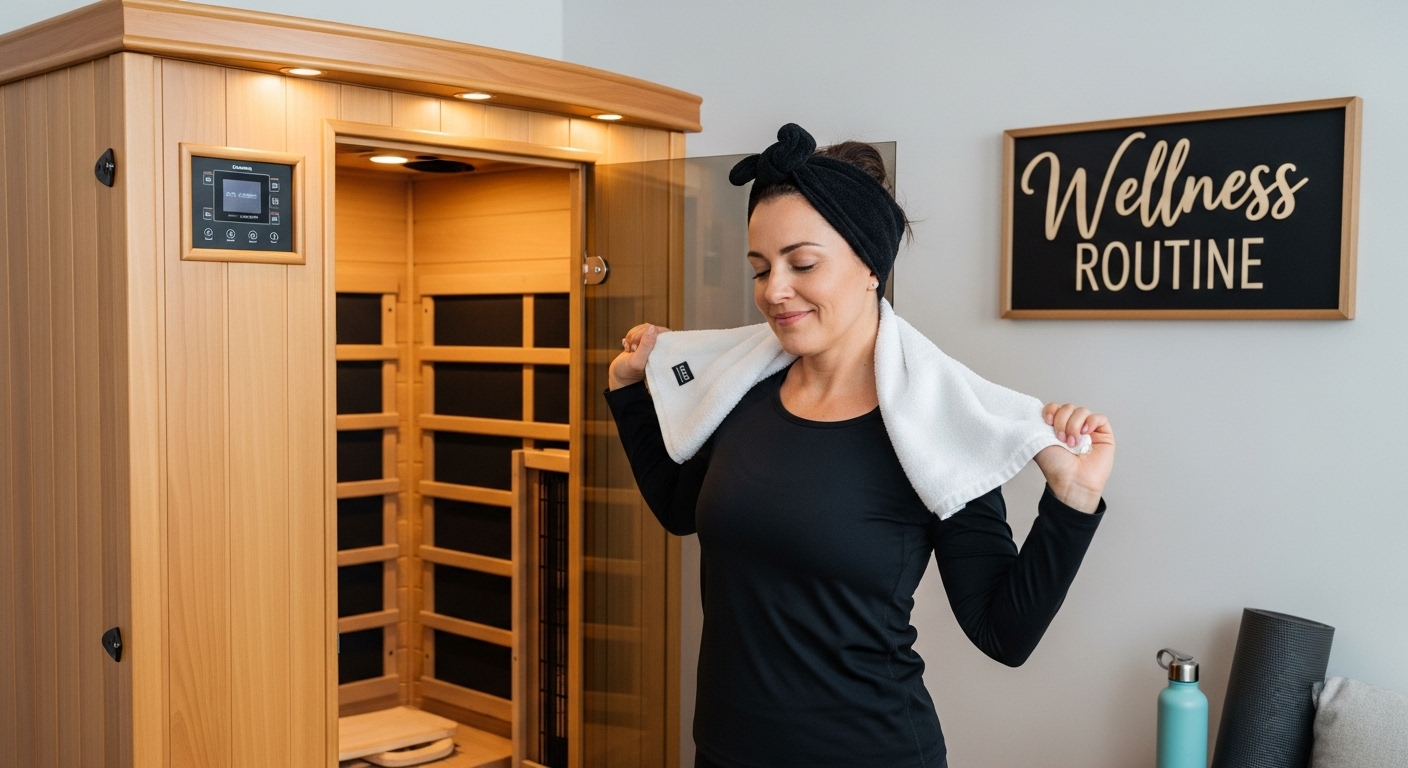
Understanding Sauna Relaxation Techniques for Wellness
People think sitting in a hot room is just about sweating and relaxing. That is only half the story. Studies show sauna sessions can trigger the parasympathetic nervous system and produce a 40 percent drop in stress hormones. It is not only your muscles that benefit. The real difference comes from specific sauna relaxation techniques that can completely shift your mind and body for deeper results than you might expect.
Table of Contents
- What Are Sauna Relaxation Techniques And Their Benefits?
- The Science Behind Heat And Relaxation In Saunas
- Different Types Of Saunas And Their Unique Relaxation Methods
- Psychological Effects Of Sauna Use On Stress And Relaxation
- Integrating Sauna Techniques Into Your Wellness Routine
Quick Summary
| Takeaway | Explanation |
|---|---|
| Engage in controlled breathing | Regulating your heart rate through controlled breathing enhances relaxation during sauna sessions. |
| Incorporate mindful meditation | Utilizing mindful meditation helps to significantly reduce mental stress while in the sauna. |
| Gradually acclimatize to heat | Slowly increasing exposure to heat ensures comfort and maximizes physiological benefits during sauna use. |
| Combine sauna with complementary practices | Pairing sauna sessions with stretching or meditation amplifies the health benefits of heat therapy. |
| Use sauna for psychological resilience | Regular sauna use can enhance mood and emotional regulation, making it an effective stress management tool. |
What Are Sauna Relaxation Techniques and Their Benefits?
Sauna relaxation techniques are specialized approaches designed to maximize the physical and mental wellness benefits of heat therapy. These methods transform a standard sauna session from a simple heat exposure into a holistic wellness experience that promotes deep physiological and psychological recovery.
Understanding Sauna Relaxation Fundamentals
Sauna relaxation techniques leverage the body’s natural response to heat to induce a state of profound calm and rejuvenation. When you enter a sauna, your body experiences a controlled stress response that triggers multiple healing mechanisms. According to research from the Mayo Clinic, these techniques work by stimulating the body’s thermoregulatory systems, which cause significant physiological changes.
The core principles of sauna relaxation include:
-
Controlled breathing to regulate heart rate
-
Mindful meditation to reduce mental stress
-
Gradual heat acclimatization for maximum comfort
Physiological and Mental Health Benefits
Scientific studies reveal that strategic sauna relaxation techniques offer extensive wellness advantages. Research published in medical journals demonstrates that these practices can significantly impact cardiovascular health, muscle recovery, and stress reduction.
The heat exposure combined with specific relaxation methods triggers the parasympathetic nervous system, which helps lower blood pressure, reduce muscle tension, and promote overall mental tranquility. By engaging in deliberate relaxation techniques during sauna sessions, individuals can transform a simple heat experience into a powerful wellness intervention.
Key benefits include enhanced blood circulation, improved skin health, muscle recovery acceleration, and substantial stress reduction. Practitioners who consistently apply structured sauna relaxation techniques report improved sleep quality, reduced anxiety, and a greater sense of physical and mental balance.
The following table organizes the primary physiological and psychological benefits of sauna relaxation techniques, providing a clear overview of their wellness impacts as discussed in the article.
| Benefit Category | Specific Benefit | Description |
|---|---|---|
| Cardiovascular Health | Enhanced blood circulation | Improves oxygen delivery and overall heart function |
| Muscle Recovery | Reduced muscle tension | Accelerates repair and relieves soreness |
| Stress Reduction | Lowered cortisol levels | Triggers parasympathetic nervous system, reducing stress hormones |
| Skin Health | Improved skin condition | Opens pores and promotes detoxification |
| Sleep Quality | Improved rest and sleep | Promotes relaxation and more restful sleep |
| Mental Resilience | Decreased anxiety, improved mood | Supports neurochemical balance for better emotional stability |
The Science Behind Heat and Relaxation in Saunas
The human body responds to sauna heat through a complex physiological process that triggers remarkable wellness mechanisms. Understanding this intricate biological response helps explain why saunas provide such profound relaxation and health benefits.
Physiological Response to Heat Exposure
When exposed to high temperatures, the human body initiates a series of adaptive responses designed to maintain internal balance. Research from Harvard Medical School reveals that heat exposure causes significant cardiovascular and neurological changes that contribute to overall relaxation.
Key physiological reactions include:
- Increased heart rate similar to moderate exercise
- Enhanced blood circulation throughout the body
- Activation of the body’s natural cooling mechanisms
- Release of endorphins and stress-reducing hormones
Neurological and Hormonal Mechanisms
Sauna heat stimulates the autonomic nervous system, particularly the parasympathetic branch responsible for rest and recovery. This neurological activation triggers a cascade of beneficial responses that promote deep relaxation and stress reduction.
The body releases endorphins during heat exposure, creating a natural mood elevation process. These neurochemicals interact with brain receptors, producing feelings of comfort and reducing pain perception. Additionally, the controlled heat stress activates heat shock proteins, which play a crucial role in cellular repair and protection.
Physiological research indicates that consistent sauna use can potentially improve cardiovascular function, boost immune response, and enhance overall metabolic efficiency. By understanding these intricate scientific processes, individuals can approach sauna relaxation as a strategic wellness intervention rather than simply a passive heat experience.
Different Types of Saunas and Their Unique Relaxation Methods
Saunas represent a diverse world of heat therapy, each offering distinctive relaxation techniques and physiological benefits. Understanding the unique characteristics of various sauna types enables individuals to select the most appropriate experience for their wellness goals.
Traditional Finnish and Dry Saunas
Traditional Finnish saunas represent the historical foundation of heat therapy. These dry heat environments typically operate at temperatures between 170 to 200 degrees Fahrenheit, with very low humidity. Medical research from infrared studies indicates that these high-temperature environments stimulate profound physiological responses.
Key characteristics of traditional saunas include:
- Intense dry heat exposure
- Wood-burning or electric heating elements
- Ability to adjust humidity through water application
- Focus on gradual heat acclimatization
Infrared and Modern Sauna Technologies
Infrared saunas represent a contemporary approach to heat therapy, utilizing electromagnetic wavelengths that directly penetrate body tissues. These saunas operate at lower ambient temperatures while providing deeper tissue heating, making them accessible to individuals who might find traditional saunas overwhelming.
The primary distinction lies in how heat is transferred: traditional saunas warm the air around the body, whereas infrared saunas directly warm body tissues. This fundamental difference creates unique relaxation experiences, with infrared technologies offering more targeted muscle and cellular recovery.
By understanding these varied sauna types, wellness enthusiasts can select experiences that align with their specific physical needs and comfort levels. Each sauna style offers a nuanced approach to relaxation, demonstrating that heat therapy is not a one-size-fits-all practice but a personalized wellness journey.
To help readers quickly compare the main types of saunas and their relaxation methods, the following table summarizes their key features and distinctions.
| Sauna Type | Heat Source | Typical Temperature (°F) | Humidity Level | Unique Relaxation Features |
|---|---|---|---|---|
| Traditional Finnish Sauna | Wood-burning/Electric | 170-200 | Low, adjustable | Dry heat, gradual acclimatization, water can be added for steam |
| Dry Sauna | Electric/Wood-burning | 170-200 | Very low | Intense dry heat, focus on heat endurance |
| Infrared Sauna | Infrared panels | 120-150 | Low | Direct tissue heating, lower air temperature, accessible for longer sessions |
| Modern Sauna Technologies | Various (often electric) | 120-180 | Variable | Targeted muscle/cellular recovery, advanced controls |

Psychological Effects of Sauna Use on Stress and Relaxation
Sauna experiences transcend physical wellness, offering profound psychological benefits that address mental health challenges in our increasingly stressful modern world. The therapeutic environment of heat and isolation creates a unique mental reset mechanism that influences neurochemical and emotional processes.
Neurochemical Stress Reduction
Scientific research demonstrates that sauna sessions trigger a complex neurochemical response directly linked to stress management. The controlled heat exposure stimulates the body’s natural relaxation mechanisms, initiating a cascade of hormonal changes that counteract chronic stress.
Key neurochemical responses include:
- Reduction of cortisol levels
- Increased endorphin production
- Enhanced serotonin regulation
- Activation of parasympathetic nervous system
Psychological Recovery and Mental Resilience
Sauna sessions function as a form of active meditation, providing a controlled environment where external stimuli are minimized. This sensory isolation allows individuals to disconnect from daily stressors, promoting introspection and emotional recalibration.
The thermal stress experienced during sauna use creates a controlled physiological challenge that builds psychological resilience. Similar to moderate exercise, heat exposure trains the brain to manage stress more effectively by improving neuroplasticity and emotional regulation. Regular practitioners often report decreased anxiety, improved mood stability, and a greater sense of mental clarity.
By understanding sauna use as a holistic wellness practice, individuals can leverage this ancient therapeutic technique as a powerful tool for mental health maintenance and stress management. The psychological benefits extend far beyond the immediate relaxation, offering a sustainable approach to emotional well-being.
Integrating Sauna Techniques into Your Wellness Routine
Creating a meaningful sauna practice requires thoughtful integration into your existing wellness framework. Strategic incorporation transforms sauna sessions from occasional experiences to powerful tools for holistic health optimization.
Designing Your Personal Sauna Strategy
Research indicates that consistent, purposeful sauna engagement yields more substantial health benefits compared to sporadic use. Developing a personalized approach involves understanding your individual wellness goals and physical capabilities.
Consider these fundamental strategy considerations:
- Align sauna sessions with specific health objectives
- Start with shorter, less intense sessions
- Gradually increase duration and temperature
- Listen to your body’s unique responses
Complementary Wellness Practices
Sauna techniques work synergistically with other wellness modalities, creating a comprehensive approach to physical and mental restoration. Integrating complementary practices can amplify the therapeutic effects of heat exposure.
Strategic combinations might include:
- Meditation before or after sauna sessions
- Gentle stretching to enhance muscle recovery
- Hydration protocols to support bodily detoxification
- Mindful breathing exercises during heat exposure
By viewing sauna use as an intentional wellness practice rather than a standalone activity, individuals can unlock more profound physiological and psychological benefits. The key lies in consistency, mindfulness, and a holistic understanding of how heat therapy interacts with overall health systems.

Experience Transformative Sauna Wellness With Best Life Sauna
If you are searching for deeper relaxation, improved stress relief, or a personalized home sauna routine, Best Life Sauna can help you put the techniques from this article into action. Many people struggle to turn knowledge about controlled breathing, mindful meditation, and the right sauna type into practical, lasting wellness habits. We offer a curated collection of premium infrared and traditional saunas to support every goal, whether you are targeting muscle recovery, better sleep, or stress management.

Take the next step now and bring holistic wellness home. Explore Best Life Sauna’s main site to discover high-quality sauna solutions designed around your needs. Our customer-focused features such as free shipping on orders over $200 and a price match guarantee make this the ideal time to upgrade your self-care journey. Start transforming your relaxation practice today with products that align with your personal wellness goals.
Frequently Asked Questions
What are sauna relaxation techniques?
Sauna relaxation techniques are specialized methods designed to enhance the physical and mental wellness benefits of heat therapy, promoting deep recovery and rejuvenation during sauna sessions.
How do sauna relaxation techniques benefit mental health?
These techniques help reduce stress by triggering neurochemical responses, decreasing cortisol levels, and activating the parasympathetic nervous system, which fosters relaxation and emotional stability.
What types of saunas are available and how do they differ?
The main types of saunas include traditional Finnish saunas, which use dry heat, and infrared saunas, which use electromagnetic wavelengths. Traditional saunas operate at higher temperatures, while infrared saunas provide deeper tissue heating at lower temperatures.
How can I incorporate sauna techniques into my wellness routine?
To effectively integrate sauna techniques, align your sessions with specific health goals, start with shorter sessions to build tolerance, and combine them with complementary practices like meditation or gentle stretching.

